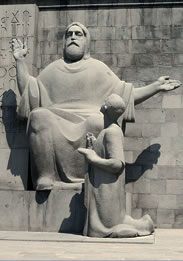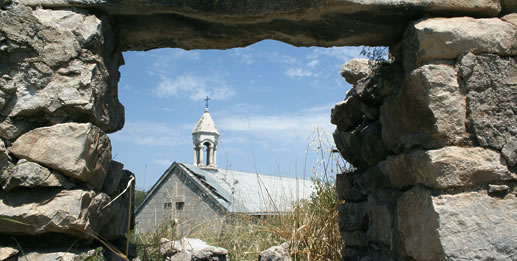History and Architecture
Nagorno Karabakh’s Amaras Monastery is one of the most treasured historical and religious sites of the South Caucasus, and one of the world’s oldest Christian monuments. It is associated with the spread of Christianity in the eastern lands of Armenia in the 4th century AD, through the mission of Armenia’s most important Christian preacher—St. Gregory the Enlightener (257 AD – 331 AD). Amaras hosts the resting place of St. Grigoris—St. Gregory’s grandson who preached the Holy Gospel to pagan tribes in what is modern-day Dagestan in the Northern Caucasus and martyred in 348 AD. Famously, Amaras was also the venue where St. Mesrob Mashtots (361 AD – 440 AD) opened the first school where the Armenian Alphabet that he invented in 406 AD was taught to pupils.
Beginning from the late 330s, for nearly 1,700 years, Amaras has served as a major ecclesiastical center in Christian Armenia. For several hundred years it hosted the headquarters of the Katholicosate of Aghvank of the Armenian Apostolic Church, before it moved from Amaras to the Gandzasar Monastery, in the late 14th century.
The monastery is located in the Martuni District of the modern Nagorno Karabakh Republic. This corresponds to the early-medieval canton of Mius Haband (Armenian: Մյուս Հաբանդ) and the late-medieval county of Varanda (Armenian: Վարանդա) of Armenia’s historical province of Artsakh. Amaras is built in the middle of the Artsakh Valley—the elevated western fringe of the Mugan Steppe—amid orchards and vineyards. Near the monastery towers Mount Lusavorich, a large forested hill. The name of the mountain is translated from Armenian as Enlightener, in reference to St. Gregory who meditated on its slopes before laying foundations to Amaras’ main church.
Some archeologists speculate that Amaras had a pre-history, and, like some early Armenian churches and monasteries, it replaced a pagan temple—most likely a Zoroastrian shrine.
In the past, Amaras was in possession of villages and large swathes of monastic land, which included mulberry orchards, vineyards, wheat fields and watermills built on the Amaras Creek. Near the monastery, there are ruins of the early medieval town of Amaras known to be an ancient regional settlement mentioned in Armenian manuscripts, specifically—in the 7th century volume called The History of the Land of Aghvank.
The history of Amaras monastery reflects the heroic and tragic history of the Armenian people who had to confront one invasion after another. Each time, Armenians rebuilt their country, including destroyed places of worship like Amaras. Amaras’ long history of destruction and restoration is also linked to the geographic position of the monastery. In contrast to many historical ecclesiastical ensembles of Armenia that were intentionally built in difficult mountains, Amaras was erected in the middle of a large plain.
In the latter half of the 5th century, Amaras suffered during Armenia’s struggle for religious freedom, known as the Vardanank—a reaction to attempts by Sassanid Persia to re-convert Armenians back to Zoroastrianism. Armenia’s resistance was led by its Sparapet (supreme military commander) St. Vardan Mamikonian, and, after Vardan’s martyrdom in 451 AD, by his nephew—Vahan Mamikonian. Shortly after Vahan and the representatives of the Persian monarch Peroz I signed the Treaty of Nvarsak in 484 AD, which recognized Armenia’s right to free Christian worship, Amaras was restored by Artsakh’s famed ruler Vachagan II the Pious. [1]
In the beginning of the Arab invasion of Armenia, in 821, Amaras was plundered again. It was restored by the efforts of one of Armenia’s most well-known opponents of the Caliphate—Yesai Arranshahik (Armenian: Եսայի Առանշահիկ, Yesai Abu-Muse in Arabic sources), ruler of Artsakh’s southern Principality of Dizak. [2] Yesai Arranshahik’s struggle against the invaders and his restoration of Amaras were epitomized in Tovma Artrzuni’s 9th century volume History of the House of Artzrunik.
In 1223, Mongol hordes reached Amaras and robbed the monastery, taking with them St. Gregory the Enlightener’s crozier and a large golden cross with 36 precious stones. According to Stepanos Orbelian’s 13th century’s work History of the Province of Syunik, the Byzantine wife of a Mongol chieftain Princess Despina persuaded her husband to send the relics to Constantinople.
In 1387, Amaras and many other religious sites in Armenia and Georgia became a target of the invading armies of the Central Asian warlord Tamerlane. According to the legend, after destroying the monastery, Tamerlane lined up the soldiers of his huge horde from Amaras all the way to the River Araxes—which are some 100 kilometers apart—and ordered them to pass stones of the dismantled church of St. Grigoris from one soldier to next and throw them into the water. But a miracle happened when the invaders left the region: a divine force lifted the stones from the river and levitated them back to Amaras, rebuilding the monastery to its original condition.
In the 17th century, Amaras experienced revival due to the efforts of Petros IV Khandzketsi, Katholicos of Aghvank—patriarch of eastern eparchies of the Armenian Apostolic Church, who reigned from 1653-1675. His disciple Bishop Barsegh Gishetsi—a native of the nearby village of Gishi—rebuilt Amaras and added some auxiliary buildings to the monastic ensemble.
From 1667 to 1671, Bishop Barsegh also built a summer campus for Amaras’ monastic brotherhood in Varanda’s village of Herher, with the church of St. Grigoris. Tympanum above the southern entrance to the church of St. Grigoris of Herher contains the following inscription in Old Armenian:
Through the grace of God, I, Bishop Barsegh, disciple of Katholikos Petros, and my parents Agha and Goulaga from the village of Gishi of the province of Varanda, renovated and illuminated the Holy See of Amaras: fortified it with walls complete with many rooms, and made the church more splendid. [And it was] ordered to build the church of St. Grigoris as a summer retreat for the Holy See of Amaras, and transfer here some of his [St. Grigoris’] relics, consigning them to earth. Founded in the summer of 1116 [of Armenian Calendar] (1667) and completed in the summer of 1125 [of Armenian Calendar] (1676). [3]
Another inscription, near the altar, written on behalf to Katholicos Petros IV Khandzketsi himself, begins with the following line:
By the will of God, I, Petros, Katholikos of Aghvank of the Holy See of Gandzasar, renovated the Holy See of Amaras—the bishop’s seat of the province of Varanda and Kochiz …
Besides renovating and expanding Amaras, Katholikos Petros IV is known for maintaining correspondence with Czar Aleksei I Romanov—father of Russia’s legendary monarch Peter I the Great (1672-1725). [4]
During the rise of the Melikdoms of Khamsa—the union of Artsakh’s five Armenian principalities—Amaras continued flourishing. In the 18th century, the Melik-Shahnazarian family, hereditary Armenian rulers of Varanda, financed further expansion of the monastery and renovation of its main structures.
In 1832, the Russian imperial authorities turned the heavily-fortified Amaras Monastery into a fortress, and then—into a customs house. And it was not until 1848, when Baghdasar Hasan-Jalaliants, head of the Holy See of Gandzasar, managed to return Amaras back into the fold of the Armenian Apostolic Church. But the many years of mismanagement and neglect took a heavy toll on the condition of the monastery’s structures. By 1858, the church of St. Grigoris had to be fundamentally rebuilt, and Armenians residents of the city of Shushi raised the money to finance the restoration works. Unfortunately, due to extensive remodeling, many features of the original building were lost. In 1898, Mikael Ter-Israelian, a stonemason from Shushi, prepared a tombstone to commemorate St. Grigoris. It replaced the old tombstone that disappeared in the 1840s.
During the Soviet times, Amaras stopped functioning as a religious site. Its clergy were expelled, and the monastic complex became a property of the collective farm of the nearby Armenian village of Soss of the Nagorno Karabakh Autonomous Oblast (NKAO). The authorities of Soviet Azerbaijan, to which NKAO was forcibly attached in 1921, did everything they could to condemn Amaras to oblivion, decay and the tyranny of the so-called “black archeologists”—criminally-minded treasure-hunters. Persistent appeals of the people of Karabakh to open Amaras for worship were rejected by Azerbaijan’s authorities. The fact remains that Soviet Azerbaijan’s Nagorno Karabakh Autonomous Oblast was the USSR’s only territory with Christian majority that did not have a single functioning church.
With the start of the Karabakh liberation movement in 1988, which struggled to remove Nagorno Karabakh from Azerbaijan and re-assign it to Soviet Armenia, Amaras became the focus of religious revival in the autonomous region. In 1988, after more than 70 years of Soviet neglect, the 1700 years old Amaras was re-consecrated, once again becoming a primary center of the Armenian Apostolic Church.
The monastery suffered during the war launched by Azerbaijan against the population of Nagorno Karabakh (1991-1994). The territory around the monastery was briefly occupied by Azerbaijan’s armed Muslim gangs, and was ransacked. The tombstone of St. Grigoris was damaged and Amaras’ walls to these days bear scars left by machineguns and shrapnel. But when Azerbaijani army was expelled from Nagorno Karabakh, the monastery was restored, and church service resumed.
Architecture of the Monastery
The historical three-volume work History of the Land of Aghvank attributed to two Armenian authors—Movses Kaghankatvatsi (7th century) and Movses Daskhurantsi (10th century)—serves as the main source about the early history of Armenia’s eastern provinces of Artsakh and Utik (modern Nagorno Karabakh). In Chapter 20 of Book I, Movses Kaghankatvatsi mentions that the original church founded by St. Gregory the Enlightener at Amaras in the 4th century was a building so large that it had not been completed one century later, when Vachagan the Pious, King of Aghvank, visited Amaras in search for the holy relics of St. Grigoris. [5] It is also likely that the original church was a domed structure, not a basilica.
The most important historical element of the monastery is the underground vaulted mausoleum that contains the grave of St. Grigoris. This is the main shrine of the monastery. The mausoleum is located under the altar of the church, representing a rectangular room 3.7 m in length, 1.9 m in width and 3.5 m in height.
A wall that survived from the original 4th century building is decorated with carved geometrical and vegetative ornaments typical for early Armenian churches. On the tombstone one can see carved images of a bishop’s tiara, a crozier, a cross, and an inscription in Old Armenian:
This is the sepulcher of Saint Grigoris, Katholikos of Aghvank and grandson of Saint Gregory Partev the Enlightener. Born in the summer of 322 AD, anointed in the summer of 340 AD, and condemned to a martyr’s death in 348 AD, in Derbent, by Sanesan, King of the Mazkuts. His holy remains were brought to Amaras by his disciples—deacons from Artsakh.
The sepulcher of St. Grigoris most closely resembles the sepulcher of the inventor of the Armenian Alphabet St. Mesrob Mashtots, which was built in 442 AD by Prince Vahan Amatuni in Oshakan (30 km from Armenia’s capital Yerevan). St. Grigoris’ sepulcher is the oldest and most characteristic of all analogous structures of early medieval Armenia.
The present-day church of St. Grigoris in Amaras was built 1855 from blocks of white sandstone extracted from the nearby quarries in the foothills of Mt. Hazaz. It is a basilica with three naves, 24 meters in length and 13.5 meters in width. The prayer room is divided into three naves by two pairs of cross-shaped columns. On both side of the apse there are rectangular and vaulted underground chapels. Since the chapels are connected with the sepulcher of St. Grigoris, their floors are several meters below the altar of the church.
The only entrance to the church is from the west. The church is naturally illuminated by four large windows.
The church of St. Grigoris has a double-pitch roof with a bell-tower that rests on six pillars. As seen from a picture published by the Ararat magazine in 1872, before its reconstruction in 1855 Amaras had as many as three bell-towers built next to each other on the same roof. The biggest and tallest of the three was in the center of the roof, and the other two were built symmetrically on the western and eastern sides of the building. Specialists believe that two bell-towers were damaged beyond repair in the beginning of the 19th century and removed in 1855. This could be inferred from the writings of Archbishop Sargis Jalaliants, who saw the original building of the church and described it in his book A Journey to Greater Armenia (1842). [6]
The western façade of the church is decorated with a large sculpted cross built under the gable and above the main entrance. A smaller cross decorates the opposite façade of the church.
From the outside the Amaras monastery represents a fort with thick, five-meter-high stone walls. Large cylindrical turrets are mounted at each of the fort’s four corners. The length of the campus is 85 meters, and width is 59 meters. The only external gate leading inside the monastery is in the south-eastern wall of the campus, which, in turn, opens toward a small courtyard. The courtyard had its own gate with a corridor leading to the church. This complicated system of entrances was created for defensive purposes, and, together with thick walls and massive turrets, was supposed to protect the monastery from invaders coming from the eastern steppes. Analogous defense schemes can be found in several fortresses and monastic ensembles throughout historical Armenia, especially in Artsakh’s neighboring province of Syunik, with the Tatev Monastery being a primary example. It is believed that the building materials for the monastery’s walls were taken from the township of Amaras, an important urban center of medieval Nagorno Karabakh destroyed in the 16th century in the course of Ottoman-Persian wars.
The monastery features multiple auxiliary and residential premises constructed as extensions of the walls. They include monk cells and a dormitory for pilgrims, all of which face the church. Near the southern wing of the church there is a refectory and a two-story house of the Father-Superior—headmaster of the monastery. Auxiliary structures include storehouses, a barn, and a stable.
[1] Bishop Barkhudarian, Makar. Artsakh. Baku, 1885
[2] Mkrtchian, Shahen. Historical and Architectural Monuments of Nagorno Karabakh. Yerevan: Hayastan Publishing House, 1988, pp. 117-121
[3] Bishop Makar Barkhudarian. Artsakh. Baku, 1885, p. 68
[4] In one of his letter dated 1672, Katholikos Petros IV writes:
“To the Czar crowned by Christ … from the slave of God, Peter (Petros), the Armenian Katholikos, with prayers of Gregory the Great of Greater Armenia (Gregory the Enlightener). I am the Patriarch of the Holy See of Gandzasar, where the holy relics of St. John the Baptist, Gregory the Great, Joseph of Arimathea, and others are located and from where we call upon the apostles of Jesus Christ and the Holy Ghost to guard your throne, the city of Moscow, and your entire kingdom …” (Source: George A. Bournoutian. Armenians and Russia, 1626-1796: A Documentary Record, Costa Mesa, CA: Mazda Publishers, 2001, p. 21)
[5] Movses Kalankatuatsi. History of the Land of Aluank, translated from Old Armenian by Sh. V. Smbatian. Yerevan: Matenadaran (Institute of Ancient Manuscripts), 1984, p. 48
[6] Jalaliants, Sargis. A Journey To Greater Armenia. Tiflis, 1842, part I, p. 196. (in Russian)




